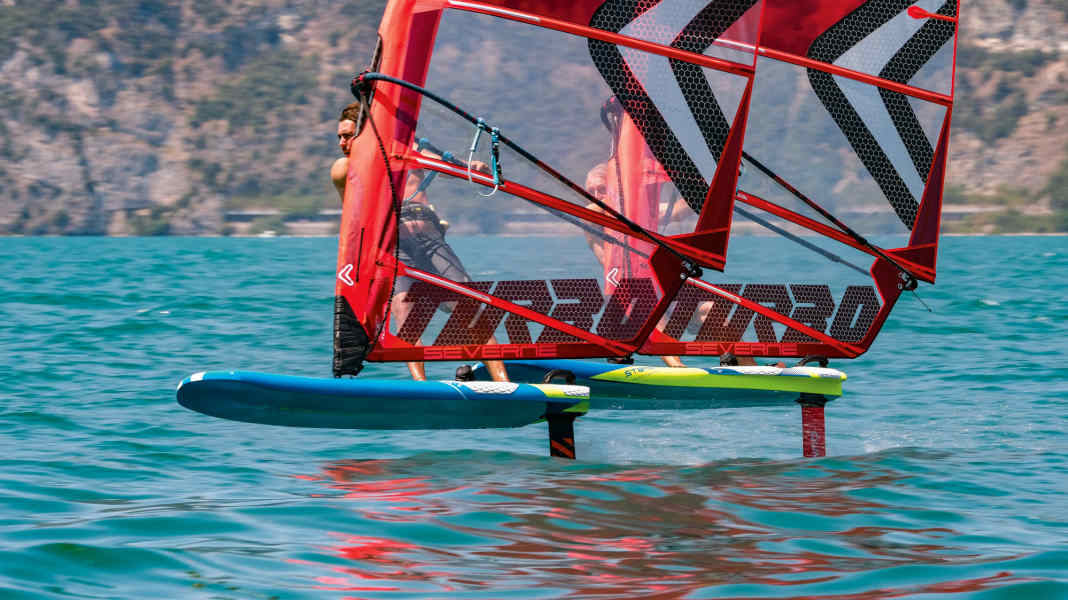
The developers' battle against the laws of physics goes on forever. As with all airfoils, lift and drag are inextricably linked. Unfortunately, the two important variables in product development generally run in opposite directions. For foils, this means: either a lot of lift at low speed or little drag at higher speeds.
We tested these freeride and freerace foils:
- F4 Freerace Carbon
- F4 Freeride Aluminium
- Fanatic Aero Free WS 1000
- GA Hybrid HP 1050
- GA Phantom SL 850
- Gunsails Hy-Foil Free 1050
- Indiana HP 1050 X-AR
- Naish Wind Wing HA 914 Carbon
- Neilpryde Glide Wind HP 13
- Neilpryde FR 90
- RRD Dynamic WS Alu Set
- Slingshot Phantasm
- Starboard Race Evolution
- Starboard Superflyer Carbon
All tested foils to click through:
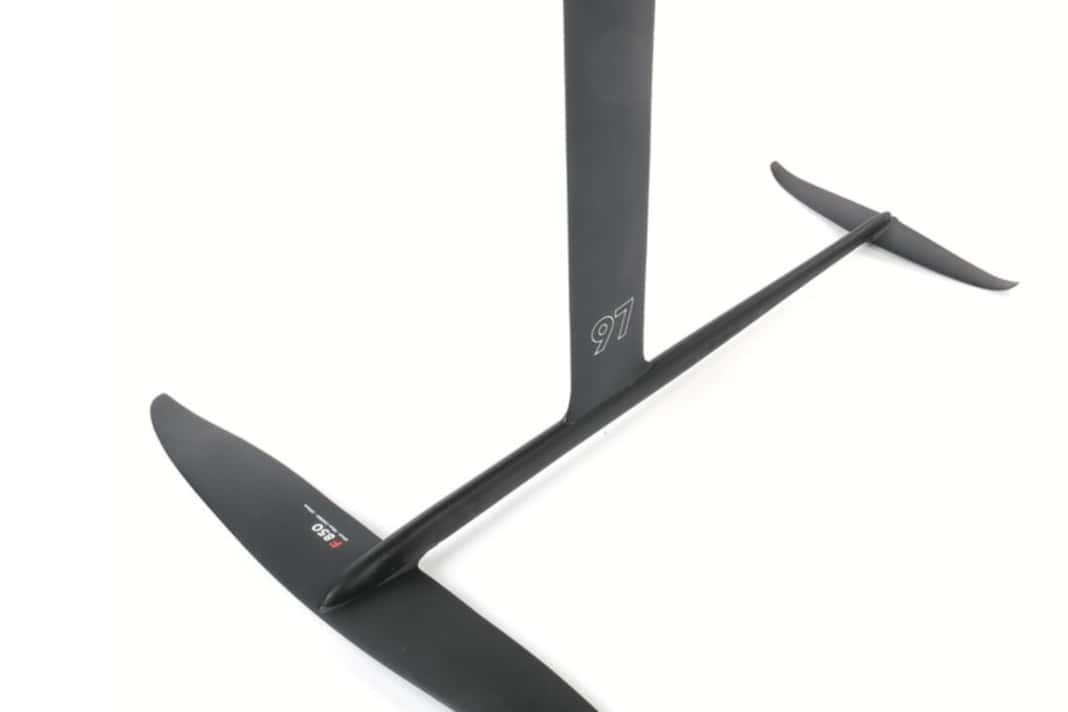





We noticed this with the freeride and freerace foils:
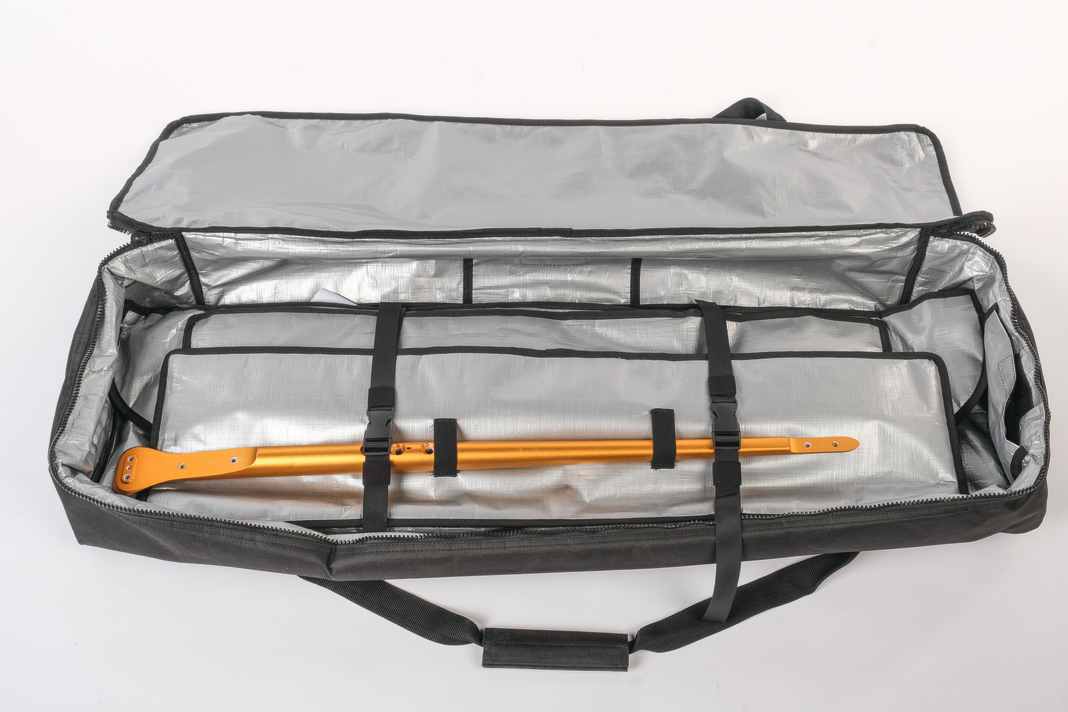





The ideal wing size for foils
Windsurfing foils are roughly between 600 and 1700 square centimetres of front wing area. Everything above this belongs mainly in the wing foil category. The larger the wing, the smaller the sail can be. On a 1700 front wing, take-off is possible with a little action even with sails of a good five square metres at three Beaufort. The pressure of larger sails of seven square metres and more would not be tolerated by such large and usually thick wings from a good four wind forces at the latest. Then the resistance becomes too great and the wing only wants to go upwards - or shows other signs of failure.
Conversely, very small foils of less than 800 square centimetres need a lot of speed to produce enough lift. So one or two knots more wind, large sails and diligent pumping until the start. From around 800 to a good 1000 square centimetres, the freerace range for surfers is between 75 and 95 kilos according to our test impressions. Foils such as the very efficient 1050 Gunsails cover even the lightest wind with ease - and are also very fast. At just 850 square centimetres, the F4 Freerace requires a noticeably longer runway to achieve the required take-off speed.
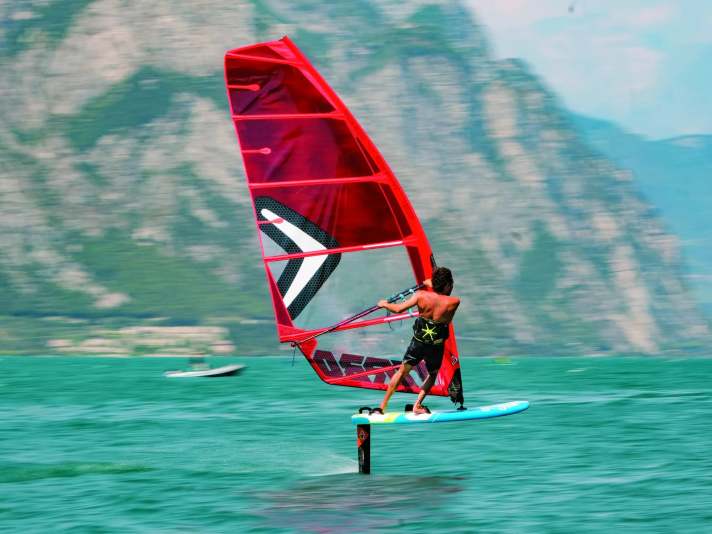
On the other hand, such foils can result in fines for exceeding the speed limit in urban areas, something you don't have to worry about on a thick early planing foil. Even smaller foils can be found in the race segment. Because when hobby surfers start flying on a 600 race foil, the wind is actually sufficient for full-throttle fins.
Light wind performance
With 7.0 sails, almost all foils met our light wind expectations - although the F4 Freerace, RRD Dynamic, NeilPryde FR and Starboard Race models require a little more active support to achieve the necessary speed. The GA Hybrid, Gunsails Hy-Foil, Fanatic Aero Free and Slingshot Phantasm convinced us with a lot of power and performance even in the lightest breeze - even in relation to the actually small surface area.
The speed rating
We have dispensed with the most subtle differences in presentation in this test. On the one hand, some differences are so clear that the foils actually play in completely different classes. On the other hand, the potential of non-racers is probably only utilised as far as the controllability of the foil allows. For example, the F4 Freerace almost certainly offers greater potential for speeds far beyond 40 km/h than the Starboard Superflyer. On the other hand, very high speeds can be reached much more easily and perhaps even in the first place. The speed potential should therefore be seen as a somewhat flexible range that can be extended upwards, depending heavily on riding ability.
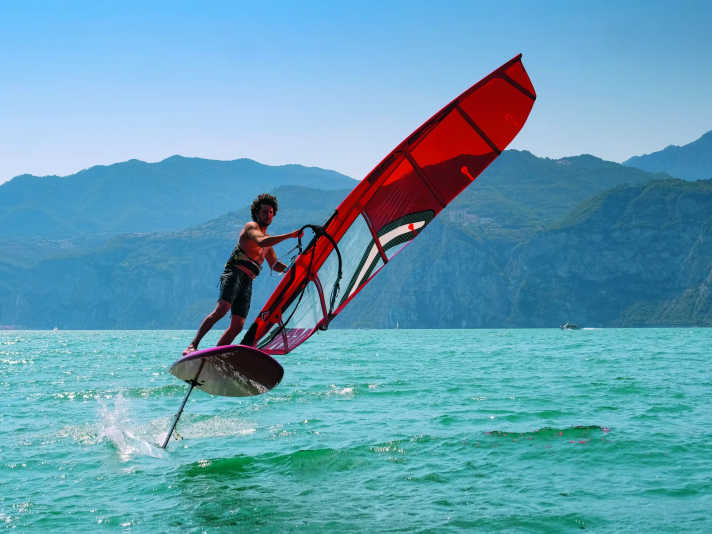
Save a lot of money with aluminium masts
The sometimes considerable prices are often due to the carbon masts, which can account for well over 1000 euros of the total price. Fortunately, aluminium masts are also often available. Carbon masts are often somewhat thinner and therefore blessed with one or two per cent more potential in the last high-end segment. Aluminium masts are sometimes even stiffer; in our tests - at least for freerace use - the aluminium masts did not show any disadvantageous properties. So there is certainly great potential for savings here.
Suitable sail sizes
Depending on the wing size, foil windsurfing starts at the lower wind limit with sails well under ~six square metres - or only with 7.0 and larger. Our 7.0 metre sails were well suited to the conditions and the foils; larger sails are possible on most foils. Only on those from Indiana, Naish, Slingshot, on the F4 Freeride, Starboard Superflyer and NeilPryde Glide would we consider the 7.0 to be the upper limit, because these foils can hardly convert any additional power and the controllability suffers.
Weight does not play a major role
In contrast to surfing with a fin, where every half kilo of board weight is noticeable, the weight of the foil and the board plays a much smaller role after the carry passage to the water. The factor of inertial mass is almost completely eliminated with the smooth, constant movement of a foil.
Caution: extra hot
The Racefoil gave us a ride on the razor's edge in demanding, undulating conditions. The NeilPryde 70 is the measure of all things on the regatta courses with a front wing that is only around 600 square centimetres in size, but should be enjoyed with a great deal of caution by hobby racers - or even not recommended. The small wing only takes off from around 20 km/h, and its lower cruising speed is around where a thick freeride wing already reaches its top speed. Potential upwards? Open! However, the small wing reacts very sensitively to - intentional and unintentional - loads and thus opens up maximum potential for very experienced race foilers. But only with large sails, a lot of sensitivity and plenty of practice.
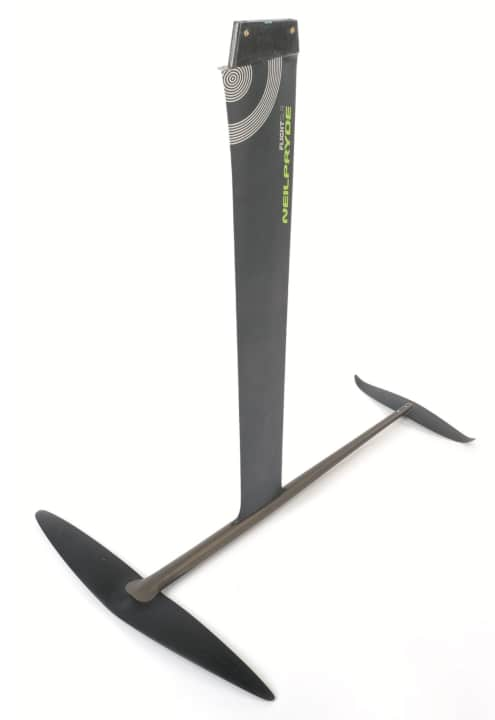
How we tested the foils
All driving impressions come from comparison trips with identical sails, supported by GPS recordings. We have checked the most important technical data. We measure the mast length as the visible length from the underside of the board to the upper edge of the fuselage. We measure the total length along the fuselage - i.e. including any wing parts that may protrude further, such as the front wing on NeilPryde. Wingtips of the rear wing that are bent backwards, such as on the Naish Wind Wing, are not taken into account.
The test results of the freeride and freerace foils
F4 Freerace Carbon
With its stretched, narrow wings, the F4-Foil has a very sporty look and shows this impressively on the water. The extremely rigid construction on all axes also looks very direct in practice. The very solid-looking mast hardly bends at all and the foil always looks predictable. It is not only easy to edge upwind (not quite as extreme as the GA), but can also be held in a controlled manner on half-wind courses. Changes in height trim are harmonious and therefore easy to predict. With little drag and almost no noise, the F4 Freerace established itself in the absolute top group in the speed comparisons, with a comparatively relaxed flying position - probably with even more speed potential than the Starboard Race. The foil impressed when foiling in sport mode, even with larger sails of 7.0 and more. The slightly higher take-off speed required is then achieved more quickly and you have enough pressure in the sail before jibing. Jibes are controlled and with sufficient lift - but only at sufficient speed. The foil is also optionally available with an aluminium mast, which saves a whopping 1214 euros.
Conclusion: A very stable top freerace foil.


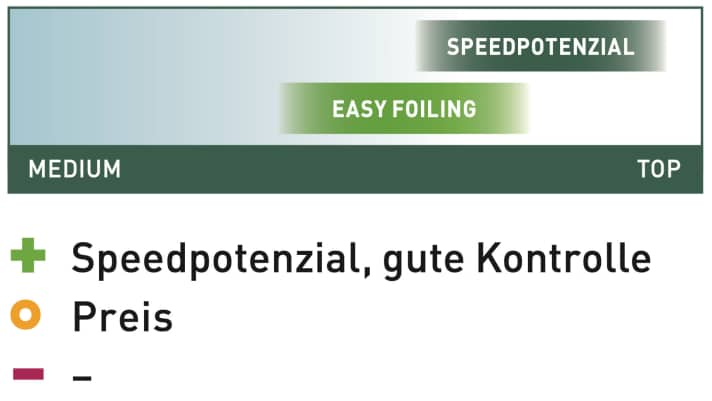
Technical data F4 Freerace Carbon
- Price: 2819 Euro
- Weight*: 5.4 kg
- Front wing: 850 cm2 / 90 cm
- Rear wing: 210 cm2 / 42.5 cm
- Fuselage/total length*: 97.5 / 99.5 cm
- Mast*: 96.5 cm
- Box systems: Deep Tuttlebox
- Info at F4 Foils Europe
*surf measurement
F4 Freeride Aluminium
The difference between freeride and freerace could hardly be greater than between the two F4 foils. In our opinion, the F4 Freeride flies more between pure manoeuvre foils and the freeride entry-level class. The foil takes off extremely early, preferably with sails under 6.0 square metres. Standing upright and without a real option to edge, the surprisingly thin wing with the compact outline purrs pleasantly through the water, glides through the biggest wind holes and offers lift in the jibe until it almost comes to a standstill. When the sail is taut and under pressure, the foil reacts quite nervously around the transverse axis, but in relaxed cruising mode the foil adapts to the relaxed mood. Even if the wide wing punctures the surface, this is not immediately acknowledged with a stall, but the foil continues to slide along the surface like a flat thrown stone, dives in and the ride continues. The foil can be pumped well with the legs, allowing slow, wide manoeuvres, but on the straights there is hardly any freeride feeling despite a little more speed than with the Starboard Superfly.
Conclusion: A manoeuvre and cruising foil.
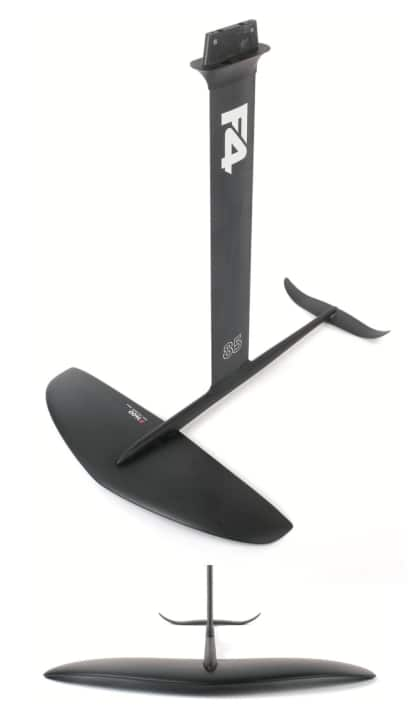


Technical data F4 Freeride Aluminium
- Price: 1475 Euro
- Weight*: 5.52 kg
- Front wing: 1400 cm2 / 77.5 cm
- Rear wing: 228 cm2 / 38 cm
- Fuselage/overall length*: 83 / 89.5 cm
- Mast*: 84.5 cm
- Box systems: Powerbox/Tuttlebox
- Info at F4 Foils Europe
*surf measurement
Fanatic Aero Free WS 1000
With a weight of just four kilos, Fanatic has achieved a very rigid full carbon construction in which all parts are solidly connected to each other. This is maximum efficiency in product design - and this is also reflected in the riding characteristics. With the 1000 front wing, the foil generates a lot of lift very early on for optimum light wind use. Even in light winds, the board on this foil can be lifted out of the water onto the wing with just one or two pumps and can be edged sportily upwind at medium speed. The lift is always quite ample, but controllable. It achieves good speeds in the front midfield, lifts off earlier than the even faster but smaller wings - and offers significantly more lift in the jibe. When manoeuvring, you tend to try to keep the nose of the board down, which means that you can foil through completely with good technique, even in very light winds. Even on the straight, you are always a little preoccupied with height control. But not in the stressful area, but at an acceptable level and without unpredictable reactions from the foil.
Conclusion: A sporty-looking, good mix of freeride and freerace for ambitious foilers.
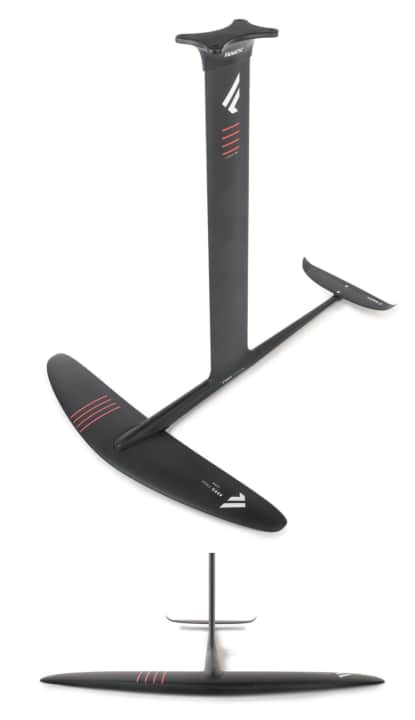
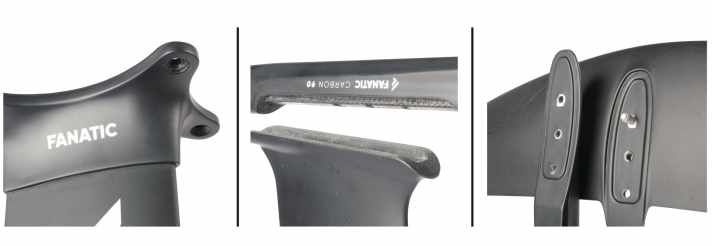

Technical data Fanatic Aero Free WS 1000
- Price: 2188 Euro
- Weight*: 4.04 kg
- Front wing: 1000 cm2 / 84 cm
- Rear wing: 215 cm2 / 36 cm
- Fuselage/total length*: 90 / 94 cm
- Mast*: 88.5 cm
- Box systems: 2xUS
- Info at Boards & More GmbH
*surf measurement
GA Hybrid HP 1050
With a price that makes entry makes windsurfing foiling much easier, GA sends the Hybrid into the race with the slim aluminium mast. The 1050 front wing lifts very early and offers good stability in flight. The noticeable increase in lift as the wind increases can also be kept well under control. The rather voluminous wing clearly indicates its speed limit below 40 km/h, but until then it appears sporty and fast with the option of pulling up effectively at a good angle. This clearly sets it apart from the leisurely foils such as the Superflyer from Starboard or the Freeride from F4 on the sportier side. It also performs particularly well in foil jibes, which can be initiated at high speed. It keeps a stable course and maintains a good flying height for long enough even with small wobbles during the foot change or when losing speed in the turn. The FR 900 wing, which was also tested, takes off noticeably later and then loads up extremely strongly, which makes control more difficult in comparison.
Conclusion: Hybrid is not only the carbon-aluminium mix of the construction of the mast and wings, but also the successful mix of freeride and freerace - if you want more, go for the Phantom.
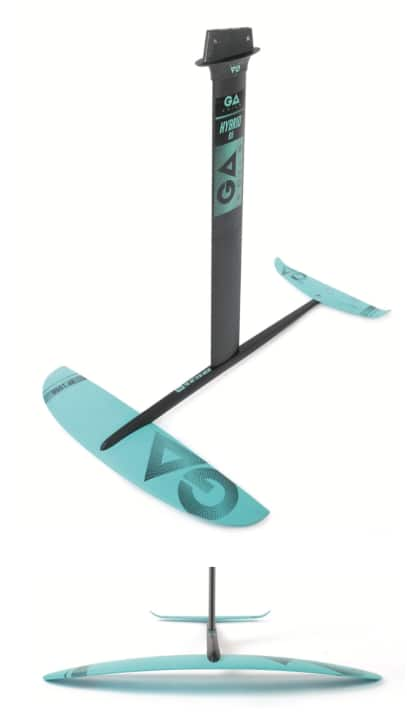
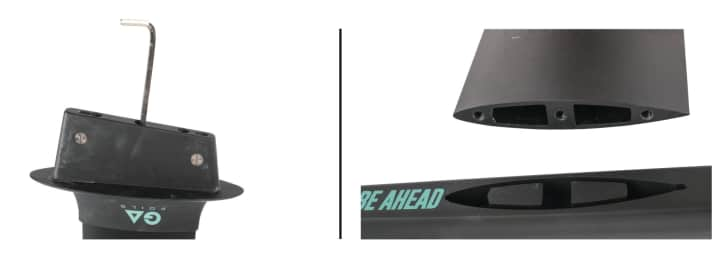

Technical data GA Hybrid HP 1050
- Price: 1129 Euro
- Weight*: 5.36 kg
- Front wing: 1050 cm2 / 76 cm
- Rear wing: 303 cm2 / 44.2 cm
- Fuselage/overall length*: 89.5 / 92 cm
- Mast*: 84.5 cm
- Box systems: 2xUS/Deep Tuttlebox/Powerbox
- Info at Newsports GmbH
*surf measurement
GA Phantom SL 850
The Phantom is already an impressive piece of equipment - with its towering mast, eternally long fuselage and massive carbon wings. The ability to foil extreme angles is particularly impressive in comparison. Of course, the foil is also fast - it is one of the fastest, but it can't quite offer the smoothness of an F4 Freerace or Starboard Race upwind. More head work is required on the GA to maintain control. But if you start luffing with the GA, you'll quickly outpace the field of freeracers. The foil can be edged so that your body almost hangs in the water - more extreme than any other foil in this group. The buoyancy can be controlled well with a committed planing, large sails are preferable on this foil. With a 7.0 or 8.0 sail, you also conceal the fact that the foil needs a little more speed to take off and you have the necessary pressure for fast foil jibes. This is because it holds its course perfectly in the jibe, but needs a good basic speed, just like the other foils with wings under the 900 mark.
Conclusion: A very powerful freerace foil that can handle even the steepest courses into the wind.
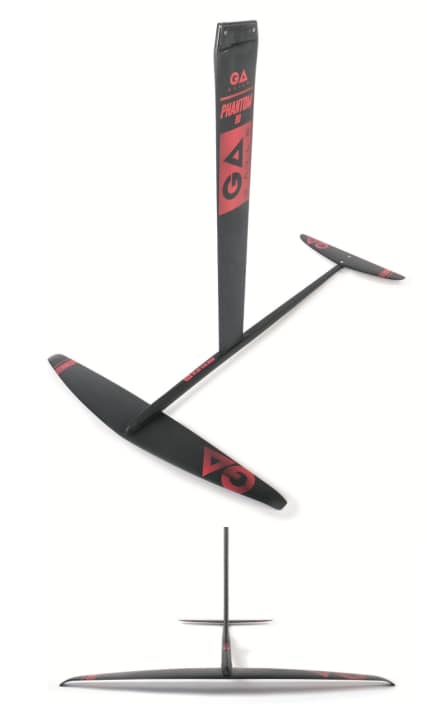
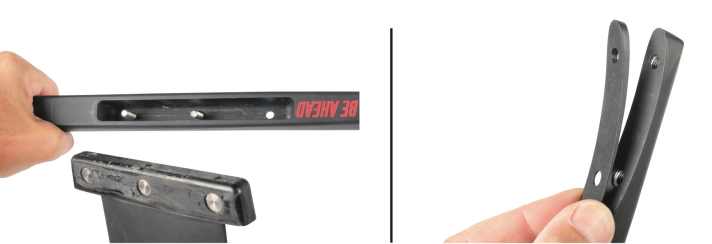

Technical data GA Phantom SL 850
- Price: 2399 Euro
- Weight*: 5.82 kg
- Front wing: 852 cm2 / 88 cm
- Rear wing: 300 cm2 / 45 cm
- Fuselage/overall length*: 109.5 / 111.5 cm
- Mast*: 90 cm
- Box systems: DeepTuttlebox
- Info at Newsports GmbH
*surf measurement
Gunsails Hy-Foil Free 1050
Red like a fire engine, the foil from Gunsails leaves nothing to be desired. Even the scope of delivery is exemplary: with all screws neatly organised in a pillbox, two carbon wings, everything in a solid bag. The 85 centimetre long mast is very stiff in all directions and sufficiently long with enough reserves in normal foiling conditions. However, these are hardly necessary thanks to the very predictable foil behaviour. The wing comes up very early even in the lightest wind - two or three pumping strokes are usually enough - and then builds up lift quickly and constantly. This allows for a sporty flying position with a lot of forward pressure on the front wing and plenty of speed even in light winds. The foil is easy to control, but not nervous - and very predictable in the up/down axis. The foil is one of the fastest, especially in medium winds. In the jibe it stays up for a long time, prefers to go through medium radii, but can also handle pressure quite well. The lift can be reduced somewhat with a spacer disc on the rear wing, then less input is sufficient for very good control of the foil even in stronger gusts.
Conclusion: Top freerace foil.
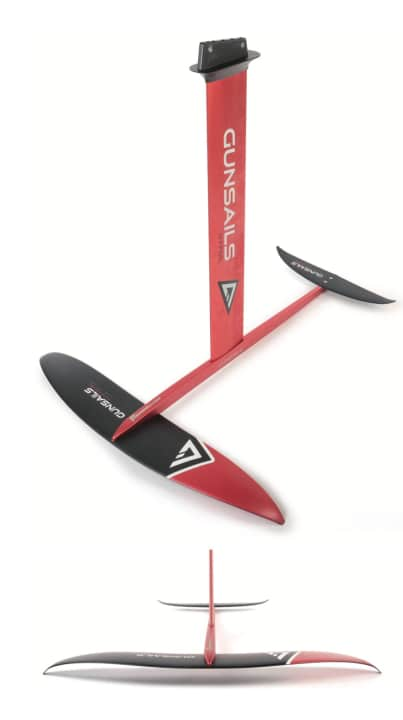


Technical data Gunsails Hy-Foil Free 1050
- Price: 899 Euro
- Weight*: 5.4 kg
- Front wing: 1050 cm2 / 90.5 cm
- Rear wing: 316 cm2 / 48.2 cm
- Fuselage/total length*: 95 / 95.5 cm
- Mast*: 82.5 cm
- Box systems: Tuttle-/DeepTuttlebox/2xUS/Powerbox
- Info at Gun Sails GmbH
*surf measurement
Indiana HP 1050 X-AR
Indiana provided us with two complete set-ups. We found the best trim with the wing sizes 1050/520, which allows you to cruise quickly and quite comfortably. The board is extremely stable in the air around the longitudinal axis and very lively around the transverse axis. This characteristic offers maximum potential for pumping with the legs, which no foil can do better in wind holes. Sail and board pumping can also be combined well when planing and a very early take-off can be initiated. This makes the set almost more like a wing foil for windsurfing. Even with the maximum rear angle of attack (+2 degrees), the board requires additional weight on the rear foot to keep the nose up when the sail is held tight. With a more upright surfing position and only moderate sail power, the foil is much more stable and better trimmed. We would therefore prefer to fly it with smaller sail sizes and slightly underpowered, as it has plenty of light wind potential. The foil is almost impossible to edge in a straight line and the radii are wide in gybes, but with a lot of planing potential.
Conclusion: Comfortable light wind freerider for smaller sail sizes.
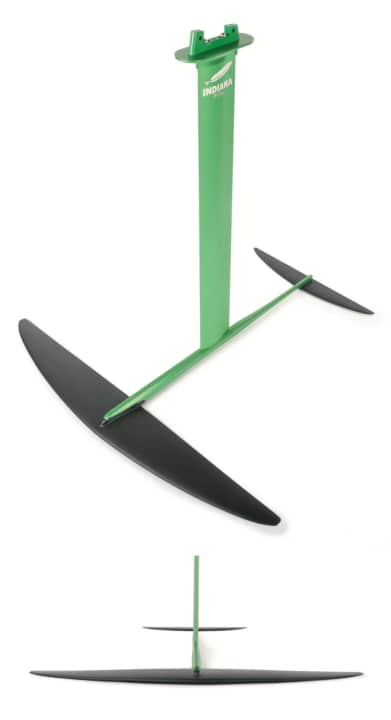


Technical data Indiana HP 1050 X-AR
- Price: 1699 Euro
- Weight*: 5.2 kg
- Front wing: 1300 cm2 / 95.5 cm
- Rear wing: 354 cm2 / 52.5 cm
- Fuselage/total length*: 90 / 94 cm
- Mast*: 91 cm
- Box systems: 2xUS/Deep Tuttlebox/Tuttlebox
- Info at Indiana Paddle & Surf
*surf measurement
Naish Wind Wing HA 914 Carbon
The sporty high-aspect upgrade should be an interesting alternative, especially for Naish fans of the first foiling lesson. Compared to the classic Wind-Wing 1150, the slightly smaller but sportier version requires at most a touch more wind, but then becomes significantly faster. In this field, the HA 914 offers a balanced combination of early lift, plenty of "easy foiling" and sufficient speed. At least the sporty freerider will enjoy the speed. However, the foil still follows the well-known Naish philosophy: not necessarily developed for giant sails or for a riding style with a heavily edged board. If you want to lean upwind in race mode, you should not be tempted by the aggressive look, the Naish does not offer the necessary counter pressure. It favours a fairly flat planing position and achieves its speed rather elegantly, with less effort and a more upright sail position on the board. The high-gloss 100 per cent carbon mast looks very classy, but also drives up the price. A Carbon 30 is included in the package for 620 euros less.
Conclusion: A fast foil for light and medium winds. More for fast freeriding than for free-racing.
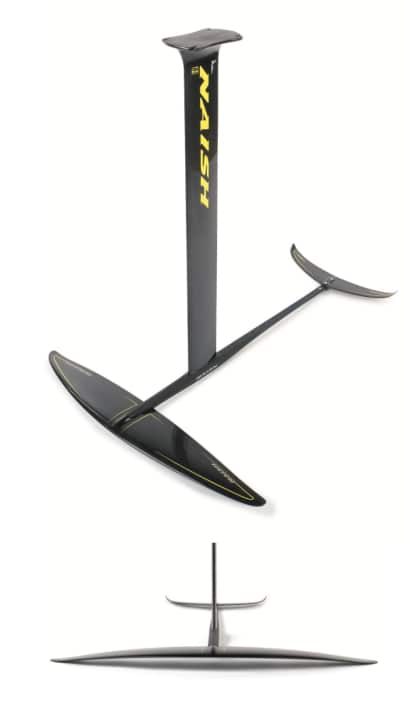
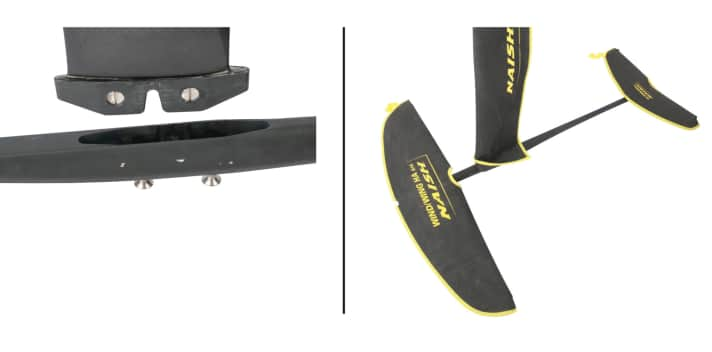

Technical data Naish Wind Wing HA 914 Carbon
- Price: 2538 Euro
- Weight*: 4.98 kg
- Front wing: 914 cm2 / 87 cm
- Rear wing: 280 cm2 / 45 cm
- Fuselage/total length*: 95 / 101.5 cm
- Mast*: 95 cm
- Box systems: 2xUS/Deep Tuttle (with adapter)
- Info at Kailua Sports
*surf measurement
Neilpryde Glide Wind HP 13
The colour coordination between the foil and the current foil board is unmatched by brands such as NeilPryde and JP. However, the gold anodised fuselage also looks very classy on its own. On the water, the Executive Flyer requires a few more metres for the take-off process when ridden passively - and a little more weight on the back foot. With active pumping via the legs, however, the foil can be lifted upwards even with very little wind. The agile position around the transverse axis makes it easier to pump or jump, but requires more attention in the cockpit when cruising. In gusts, the foil needs to be actively steered. If you just hang tiredly on the fork, the lively foil behaviour will quickly wake you up. In a jibe, it wants to be held up by tail loading, but then offers plenty of lift even at very slow speeds at the end of the jibe. In the speed rating, the Glide offers a little more potential than the Starboard Superflyer, but not its extremely easy flight control. In the end, both play in the moderate freeride league, as the foil can't be edged hard enough for freerace demands.
Conclusion: A light wind manoeuvring foil, rather for smaller sail sizes.
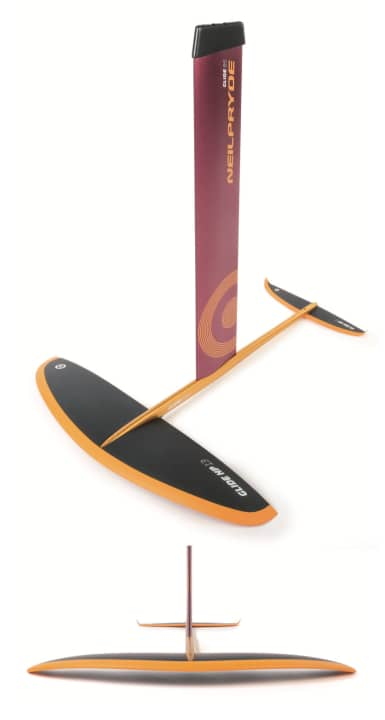


Technical data Neilpryde Glide Wind HP 13
- Price: 1278 Euro
- Weight*: 4.76 kg
- Front wing: 1300 cm2 / 80 cm
- Rear wing: 220 cm2 / 38.5 cm
- Fuselage/overall length*: 80.5 / 82.5 cm
- Mast*: 84.5 cm
- Box systems: Powerbox/Tuttlebox/2xUS
- Info at Pryde Group GmbH
*surf measurement
Neilpryde FR 90
The FR 90 cannot hide some racing genes: the elegant connection of the front wing is the same as on the super-fast SLR, and the arrangement of the wings and the mast on the fuselage are also strongly based on its design. In the take-off phase, the foil needs a little more speed than a Gunsail, but starts earlier than the Starboard Race. This allows you to sort your feet into the loops before the foil takes off. The flying position remains agile around both axes and requires a somewhat experienced pilot - but also opens up a very high speed potential. The foil tends to pull the nose down, which can be compensated for by putting weight on the back foot - and is similar to normal planing windsurfing. Even two spacer discs for more angle on the rear wing do not change this character. A nimble foot is therefore also required when initiating the jibe in order to immediately put weight on the back of the board again after slipping out of the tail loop. But then fast foil jibes are possible. On the straights, the board edges up moderately. The masts of the first series whistle very loudly, a replacement is planned.
Conclusion: Fast, agile foil with slightly higher demands.
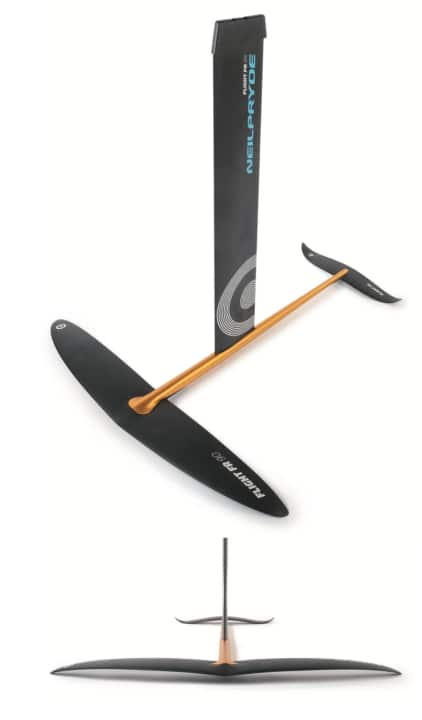


Technical data Neilpryde FR 90
- Price: 1378 Euro
- Weight*: 4.78 kg
- Front wing: 1000 cm2 / 90 cm
- Rear wing: 225 cm2 / 40 cm
- Fuselage/overall length*: 83 / 90 cm
- Mast*: 83.5 cm
- Box systems: Powerbox/DeepTuttlebox/2xUS
- Info at Pryde Group GmbH
*surf measurement
RRD Dynamic WS Alu Set
The RRD shows impressively, that even a cheaper foil with an aluminium mast can deliver a sporty feel and performance. The 85 mm mast is stiff and can be adapted to different box systems with various adapters. The small wing requires a little more speed to take off - i.e. larger sails or pumping aid - like an F4 Freerace or Starboard Race. When flying low it reacts well to foot control, seems lively around the longitudinal axis of the board, but quite stable and pleasantly moderate around the critical transverse axis (up/down). It edges well and can be manoeuvred in race mode with pressure on the front wing. The speeds are good from medium pressure in the sail. With a lot of speed, it prefers to go into jibes, it maintains a stable turn and altitude. However, speed is the order of the day, the sleek foil is not a base for slow-motion manoeuvres. The flying position is well trimmed, there are no adjustment options - the foil harmonised perfectly with our 7.0 test sail. In gusts, the lift increases in a controlled manner, which can be easily controlled by loading.
Conclusion: Sporty, fast foil for larger sails or a little more wind.
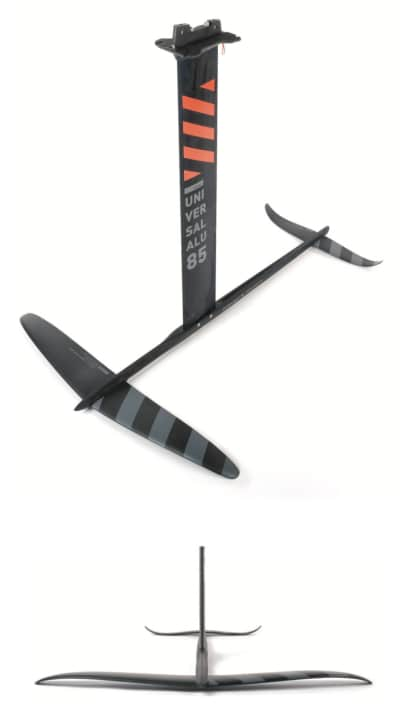


Technical data RRD Dynamic WS Alu Set
- Price: 1499 Euro
- Weight*: 5.65 kg
- Front wing: 768 cm2 / 84.3 cm
- Rear wing: 281 cm2 / 50 cm
- Fuselage/total length*: 110 / 110 cm
- Mast*: 83.8 cm
- Box systems: Tuttlebox/2xUS
- Info at Pryde Group GmbH
*surf measurement
Slingshot Phantasm
The Slingshot is presented in the most elegant packaging, just like in a jeweller's shop. The 12 K carbon mast (aluminium masts are available from 309 euros) comes in its own robust and elegant bag. On the water, the Slingshot has a lot to offer, especially in the lower and medium wind range. With a good 1200 cm2 surface area, it takes to the air with minimal pumping aid and only runs a little unsteadily for the first few metres during the impressive acceleration phase. However, it increasingly stabilises and offers plenty of speed with good controllability in the entire light wind spectrum. The foil really seems to fly through the water silently and with very little drag, while the long mast provides a very sublime feeling. It reacts calmly, moderately and is easy to control at altitude. The foil offers the best glide through wind holes and jibes - and allows sporty, fast turns, but also carries on for a very long time through leisurely jibes at low input speed. The foil is not extremely easy to edge on the straights, but impresses with an average speed that feels unaffected by wind holes.
Conclusion: Sporty, elegant light wind foil.
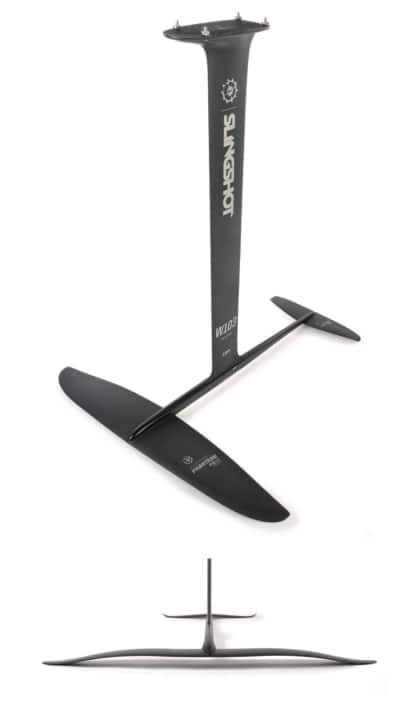


Technical data Slingshot Phantasm
- Price: 2408 Euro
- Weight*: 5.1 kg
- Front wing: 1263 cm2 / 92.5 cm
- Rear wing: 280 cm2 / 40 cm
- Fuselage/overall length*: 87 / 88.5 cm
- Mast*: 104 cm
- Box systems: 2xUS/Tuttlebox (with adapter)
- Info at SSB Trading Agency
*surf measurement
Starboard Race Evolution
Are you still screwing? Or are you already foiling? Starboarders have to put up with this little teasing when working on their equipment, which requires particularly thorough screwing. However, this small loss of time is easily made up for on the water. Because the Race Evo impresses with very good speed, combined with very easy controllability. With no other foil is it as easy and safe to reach such high speeds above 40 km/h. It holds its position without much effort, especially when controlling the height, and provides maximum safety. Every rise and sink is predictable and allows sufficient time to react. It can be manoeuvred very well upwind and thus conveys a very sporty freerace feeling with very good upwind potential, which is also reflected in objective speed measurements. With a little pumping assistance, it launches well and continues to fly smoothly for a long time in turbulence. On land, the long mast and the long fuselage are somewhat unwieldy, but on the water this ensures flight stability and very good reserves at altitude.
Conclusion: A high-priced, but also very high-quality foil with the very best freerace potential.
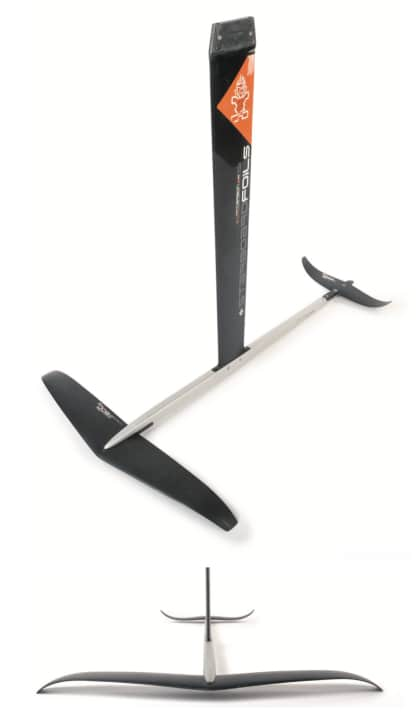


Technical data Starboard Race Evolution
- Price: 2768 Euro
- Weight*: 5.8 kg
- Front wing: 800 cm2 / 80.3 cm
- Rear wing: 255 cm2 / 40 cm
- Fuselage*/total length*: 111.5 / 113.5 cm
- Mast*: 95.5 cm
- Box systems: Deep Tuttlebox
- Info at APM Marketing GmbH
*surf measurement
Starboard Superflyer Carbon
Easier and quieter than with the Superflyer you can only fly with a hot air balloon. After one or at most two courageous pulls on the sail, the 1300 wing lifts you upwards and then holds its course and altitude almost as stable as the Wuppertal suspension railway. Gusts or incorrect loads? Of course, the foil reacts to them - but in super slow motion and with the smallest of deflections. This characteristic also accompanies you through the jibe, small or major load errors only take the foil slightly off course - the foot change is easier than on all other foils. However, the Superflyer clearly belongs to the freeride class and not to the freerace genre. The foil can be loaded well with a planing load and can at least be edged slightly. You can achieve a good angle, but not breathtaking speeds: The 1300 square centimetres of well-lined front wing have a built-in top speed on all courses, which does not limit the comfort-oriented freerider, but is clearly too low for a budding freeracer. The ideal sails are no larger than a maximum of seven square metres.
Conclusion: Extremely comfortable freeride foil with the title "easiest foil jibe".
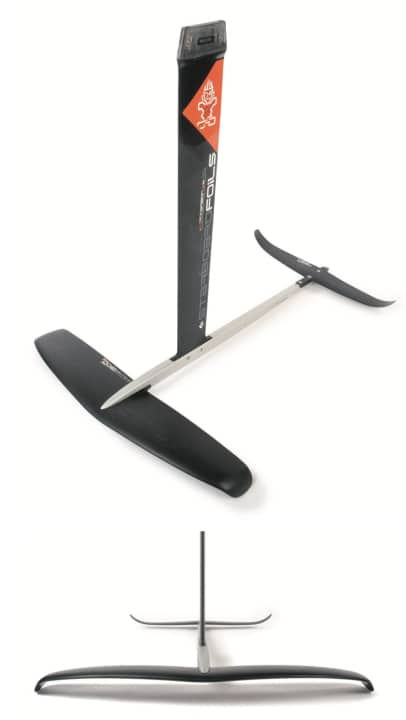


Technical data Starboard Superflyer Carbon
- Price: 2669 Euro
- Weight*: 5.0 kg
- Front wing: 1300 cm2 / 82 cm
- Rear wing: 330 cm2 / 59.5 cm
- Fuselage*/total length*: 98.3 / 100.8 cm
- Mast*: 85.5 cm
- Box systems: Deep Tuttlebox
- Info at APM Marketing GmbH
*surf measurement

